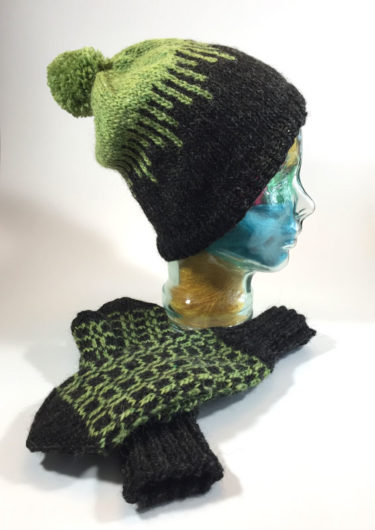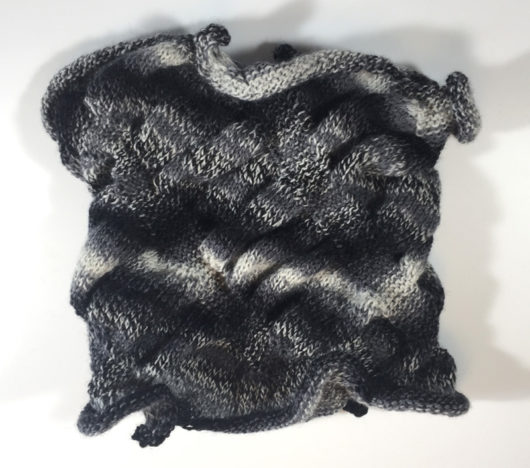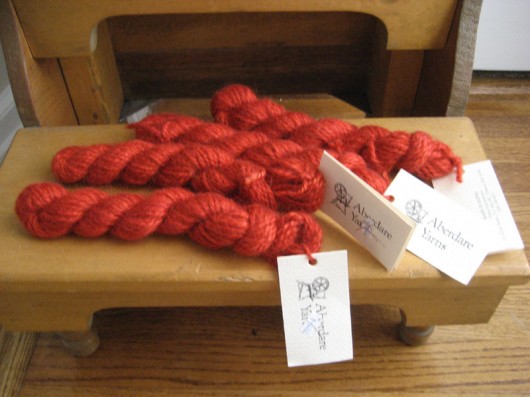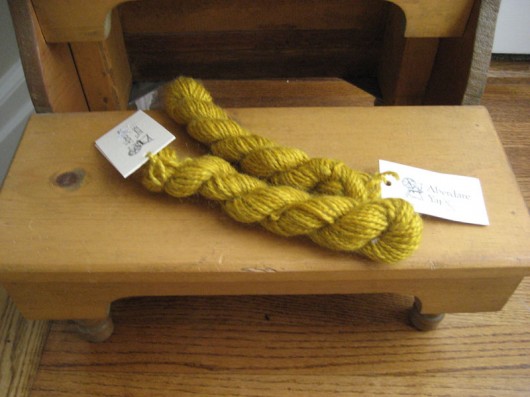This knit started back in 2014 when one of my knitworthy nieces traveled to Iceland. She had a great vacation and brought me back Léttlopii by Istex. The real Lopi. The Lopi skeins that have Icelandic labels. Spring Green and Black Heather:
Yes, I know that Reynolds Lite Lopi is essentially the same yarn. But these skeins had traveled far and they needed to be knit into something that honored their Icelandic roots. I wasn’t sure what I’d make of it. Mittens, I figured. But I couldn’t initially find a two-color pattern that I liked. And so the yarn made its way deeper into my stash. Then came my current stash down effort. I found Hlekkir by Hildur Ýr Ísberg and decided it was perfect for my Lopi. It’s a freebie on Ravelry. The pattern is available in Icelandic and in English. I chose the English version.
Nice “afterthought” thumbs blend perfectly into the patterning. Hlekkir is an Icelandic word that means “links on a chain.” That perfectly captures it!
My niece and I had an interesting long distance text session on the fit. I had a very difficult time explaining what measurements I needed. She sent me this to help out:
It didn’t help much. The distance from the base of the thumb to the top of the middle finger–in the normal world–is measured this way. But a diagonal measure doesn’t work in the knitting world. I had Steve trace my hand and then I measured his tracing. I thought the man was a bit too much of a detail guy, as he traced every gnarly bump. And he seems to have been a tad more adept on the thumb as compared with the rest of my digits. I assure you that I have all my fingers and that they’re approximately normal looking. But, from this sketch, my niece understood what I needed.
I got back the best reply possible. My niece told me our hand sizes are the same. “O frabjous day! Callooh! Callay!”
I thought about adapting Hlekkir’s chain link pattern to knit a hat. You’d think I’d have made enough hats to make that easy. But my design skills failed me and, instead, I made Bethany Hill’s Drips, another Ravelry freebie. So, meet Lopi Drips.
OK, I snuck in yet another hat. I wasn’t supposed to do that. But this is an extra-excellent hat. It’s meant to resemble the drips on the outside of a paint can. Think this:
Reimagined as this:
Very cool!
And, after that digression, back to stuff for hands. These are Aimee Alexander’s Farm to Market Mitts. Mine are knit in Plymouth Yarn’s DK Merino Superwash.
That interwoven cable is a big favorite of mine. This is the 5th pair I’ve knit!
I’ve been known to goof and get one of those twists wrong. But, in this pair, I didn’t fall asleep at the switch. This pair? This pair is finally one for me.
The next pair of mitts is Ann Budd’s In-A-Pinch Fingerless Mitts. Mine are knit in Lion Brand LB Collection Merino Yak Alpaca, an Aran weight. One ball, 126 yards/60 grams, was enough for the pair. Budd herself gave me that skein of yarn and the pattern at a knitting retreat last year. I weighed out the yarn, as Budd recommended, and separated the skein into two equal balls to knit the mitts. And it almost worked! I just had to shorten the mitts by a few rounds.
The mitt pattern has a few difficulties. I’ve added the clarifications that one Raveler says came right from the horse’s mouth/pen (Budd) to my Rav project page. That should help if you’re of a mind to give these a try.
These next mitts are Amanda Scheuzger’s Mt. Battie Mitts. Mine are knit in Stonehedge Fiber’s Shepherd’s Wool Worsted. I thought possibly the cabling would drive me batty, but the cable work was actually a lot of fun.

Did you notice that the twists reverse from one hand to the other? Nice touch. You only need two cable needles on one of the rounds. The palms of the mitt are knit plain. That works well. The only minor revision I’d make next time is I’d put the 15 thumb stitches on a waste yarn and come back later and knit taller thumbs (in the round). That’s because my thumbs would welcome a bit more coverage.
These fit well and will serve well.
Speaking of hands…
I found this sorting through my box of childhood sentimental stuff. This is my hand back in 1957. I was five. My kindergarten teacher was Mrs. Gale. I didn’t like her. Not one bit. I also didn’t like kindergarten. Less than not one bit. One day we were commanded to put our hand in–whatever this is, possibly Plaster of Paris. My mom kept my hand mold in her stash of sentimental stuff and eventually she gave it it to me. I recently photographed the mold and then pitched it. My mom didn’t know what to do with it, so she gave it to me. I decided I’d relieve the next generation of trying to figure out what to do with it. There’s a photo if I want to see it again.
I am satisfied with how my hands grew up. They know how to work. They know how to play. And they learned how to knit. Good hands.

































